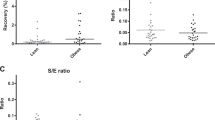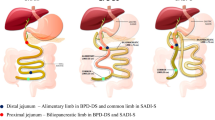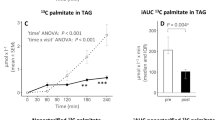Abstract
Background/Objectives:
The vitamin E derivative, α-tocopheryl acetate, is often included in formulations used in enteral nutrition. In this respect, we compared α-tocopherol and α-tocopheryl acetate absorption under ‘maldigestion’ conditions, such as occurring during enteral tube feeding, using differentially labeled RRR-[5,7-methyl-(2H6)]-α-tocopherol and RRR-[5-methyl-2H3]-α-tocopheryl acetate allowing direct comparison between free and esterified forms.
Subjects/Methods:
The two derivatives were given together in a single dose to six volunteers directly into the jejunum using a double-balloon perfusion system. Perfusion lasted for 1 h, and the collected blood and effluent samples were analyzed by liquid chromatography–mass spectrometry.
Results:
In the isolated 20-cm length of exposed jejunum, on average ∼6% of the two vitamin E forms were absorbed >1 h based on subtraction of effluent from influent. There was substantial difference in the absolute absorbed quantity between individuals, but no significant differences were observed in the absorption between the two labeled forms as assessed in the plasma. 2H3-α-tocopherol was not present in the influent, but appeared in the effluent, indicating that the acetylated form of vitamin E is cleaved by brush border enzymes in the small intestine.
Conclusions:
This study shows that even in the absence of digestive enzymes and bile salts, the appropriately solubilized acetylated form of α-tocopherol exhibits the same bioavailability as free α-tocopherol. This suggests that both forms can be absorbed equally under maldigestion conditions such as present clinically during enteral tube feeding.
This is a preview of subscription content, access via your institution
Access options
Subscribe to this journal
Receive 12 print issues and online access
$259.00 per year
only $21.58 per issue
Buy this article
- Purchase on Springer Link
- Instant access to full article PDF
Prices may be subject to local taxes which are calculated during checkout




Similar content being viewed by others
References
Ball G . Bioavailability and analysis of vitamins in foods. Vitamin E. Chapman and Hall: London, 195–239 1998.
Ruperez FJ, Martin D, Herrera E, Barbas C . Chromatographic analysis of alpha-tocopherol and related compounds in various matrices. J Chromatogr A 2001; 935: 45–69.
Burton GW, Joyce A, Ingold KU . Is vitamin E the only lipid-soluble, chain-breaking antioxidant in human blood plasma and erythrocyte membranes? Arch Biochem Biophys 1983; 221: 281–290.
Hoppe PP, Krennrich G . Bioavailability and potency of natural-source and all-racemic alpha-tocopherol in the human: a dispute. Eur J Nutr 2000; 39: 183–193.
Ingold KU, Webb AC, Witter D, Burton GW, Metcalfe TA, Muller DP . Vitamin E remains the major lipid-soluble, chain-breaking antioxidant in human plasma even in individuals suffering severe vitamin E deficiency. Arch Biochem Biophys 1987; 259: 224–225.
Morrissey PA, Sheehy PJ . Optimal nutrition: vitamin E. Proc Nutr Soc 1999; 58: 459–468.
Bramley PM, Elmadfa I, Kafatos A, Kelly FJ, Manios Y, Roxborough HE et al. Vitamin E. J Sci Food Agr 2000; 80: 913–938.
Traber MG, Sies H . Vitamin E in humans: demand and delivery. Ann Rev Nutr 1996; 16: 321–347.
Gey KF, Puska P, Jordan P, Moser UK . Inverse correlation between plasma vitamin E and mortality from ischemic heart disease in cross-cultural epidemiology. Am J Clin Nutr 1991; 53: 326S–334S.
Brigelius-Flohe R, Traber MG . Vitamin E: function and metabolism. FASEB J 1999; 13: 1145–1155.
FAO/WHO (Food and agriculture organization of the united nations/World Health Organization) Human Vitamin and Mineral Requirements 2002 121–131.
Muller DP, Harries JT, Lloyd JK . The relative importance of the factors involved in the absorption of vitamin E in children. Gut 1974; 15: 966–971.
Jeanes YM, Hall WL, Ellard S, Lee E, Lodge JK . The absorption of vitamin E is influenced by the amount of fat in a meal and the food matrix. Br J Nutr 2004; 92: 575–579.
Bruno RS, Leonard SW, Park S, Zhao YY, Traber MG . Human vitamin E requirements assessed with the use of apples fortified with deuterium-labeled alpha-tocopheryl acetate. Am J Clin Nutr 2006; 83: 299–304.
Roxborough HE, Burton GW, Kelly FJ . Inter- and intra-individual variation in plasma and red blood cell vitamin E after supplementation. Free Radic Res 2000; 33: 437–445.
Traber MG, Rader D, Acuff RV, Ramakrishnan R, Brewer HB, Kayden HJ . Vitamin E dose-response studies in humans with use of deuterated RRR-alpha-tocopherol. Am J Clin Nutr 1998; 68: 847–853.
Traber MG, Ramakrishnan R, Kayden HJ . Human plasma vitamin E kinetics demonstrate rapid recycling of plasma RRR-alpha-tocopherol. Proc Natl Acad Sci USA 1994; 91: 10005–10008.
Lodge JK, Traber MG, Elsner A, Brigelius-Flohe R . A rapid method for the extraction and determination of vitamin E metabolites in human urine. J Lipid Res 2000; 41: 148–154.
Proteggente AR, Turner R, Majewicz J, Rimbach G, Minihane AM, Krämer K et al. Noncompetitive plasma biokinetics of deuterium-labeled natural and synthetic alpha-tocopherol in healthy men with an apoE4 genotype. J Nutr 2007; 135: 1063–1069.
Sagalowicz L, Michel M, Adrian M, Frossard P, Rouvet M, Watzke HJ et al. Crystallography of dispersed liquid crystalline phases studied by cryo-transmission electron microscopy. J Microsc 2006; 221: 110–121.
Yaghmur A, de CL, Sagalowicz L, Leser ME, Glatter O . Control of the internal structure of MLO-based isasomes by the addition of diglycerol monooleate and soybean phosphatidylcholine. Langmuir 2006; 22: 9919–9927.
Lennernas H, Ahrenstedt O, Hallgren R, Knutson L, Ryde M, Paalzow LK . Regional jejunal perfusion, a new in vivo approach to study oral drug absorption in man. Pharm Res 1992; 9: 1243–1251.
Santos J, Bayarri C, Saperas E, Nogueiras C, Antolin M, Mourelle M et al. Characterisation of immune mediator release during the immediate response to segmental mucosal challenge in the jejunum of patients with food allergy. Gut 1999; 45: 553–558.
Santos J, Saperas E, Nogueiras C, Mourelle M, Antolin M, Cadahia A et al. Release of mast cell mediators into the jejunum by cold pain stress in humans. Gastroenterology 1998; 114: 640–648.
Lennernas H . Human jejunal effective permeability and its correlation with preclinical drug absorption models. J Pharm Pharmacol 1997; 49: 627–638.
Lennernas H . Human intestinal permeability. J Pharm Sci 1998; 87: 403–410.
Lennernas H, Nylander S, Ungell AL . Jejunal permeability: a comparison between the ussing chamber technique and the single-pass perfusion in humans. Pharm Res 1997; 14: 667–671.
Takamatsu N, Kim ON, Welage LS, Idkaidek NM, Hayashi Y, Barnett J et al. Human jejunal permeability of two polar drugs: cimetidine and ranitidine. Pharm Res 2001; 18: 742–744.
Nagy K, Courtet-Compondu MC, Holst B, Kussmann M . Comprehensive analysis of vitamin E constituents in human plasma by liquid chromatography-mass spectrometry. Anal Chem 2007; 79: 7087–7096.
Cheeseman KH, Holley AE, Kelly FJ, Wasil M, Hughes L, Burton G . Biokinetics in humans of RRR-alpha-tocopherol: the free phenol, acetate ester, and succinate ester forms of vitamin E. Free Radic Biol Med 1995; 19: 591–598.
Leonard SW, Good CK, Gugger ET, Traber MG . Vitamin E bioavailability from fortified breakfast cereal is greater than that from encapsulated supplements. Am J Clin Nutr 2004; 79: 86–92.
Chuang JC, Matel HD, Nambiar KP, Kim SH, Fadel JG, Holstege DM et al. Quantitation of [5-14CH3]-(2R, 4′R, 8′R)-alpha-tocopherol in humans. J Nutr 2011; 141: 1482–1488.
Brisson L, Castan S, Fontbonne H, Nicoletti C, Puigserver A, Ajandouze H . Alpha-tocopheryl acetate is absorbed and hydrolyzed by Caco-2 cells comparative studies with alpha-tocopherol. Chem Phys Lipids 2008; 154: 33–37.
Acknowledgements
We thank Rosemarie Jenni, Corinne Appolonia-Nouzille, Veronique Clement and Drs Laurent Fay, Michael Affolter, Corinne Magliola, Serge Rezzi and Martin Leser for the constructive consultations and for their valuable help. We also thank Milagros Gallart, Monserrat Casellas, Purificación Rodríguez for their help in preparing perfusion buffers and assisting on experimental procedures. This work was funded by Nestec Ltd, Switzerland.
Author information
Authors and Affiliations
Corresponding author
Ethics declarations
Competing interests
Kornél Nagy, Marie-Claude Courtet-Compondu, Sophie Braga-Lagache, Karine Redeuil, Maurice Beaumont, Julie Moulin, Simon Acquistapache, Laurent Sagalowicz and Birgit Holst are employees of Nestle (Nestec Ltd). Gary Williamson was previously a part time employee of Nestle (Nestec Ltd) and Martin Kussmann was previously an employee of Nestle (Nestec Ltd). Remaining authors declare no conflict of interest.
Rights and permissions
About this article
Cite this article
Nagy, K., Ramos, L., Courtet-Compondu, MC. et al. Double-balloon jejunal perfusion to compare absorption of vitamin E and vitamin E acetate in healthy volunteers under maldigestion conditions. Eur J Clin Nutr 67, 202–206 (2013). https://doi.org/10.1038/ejcn.2012.183
Received:
Revised:
Accepted:
Published:
Issue Date:
DOI: https://doi.org/10.1038/ejcn.2012.183
Keywords
This article is cited by
-
Can vitamin E ester derivatives be excellent alternatives of vitamin E: state of art
Bioprocess and Biosystems Engineering (2023)



